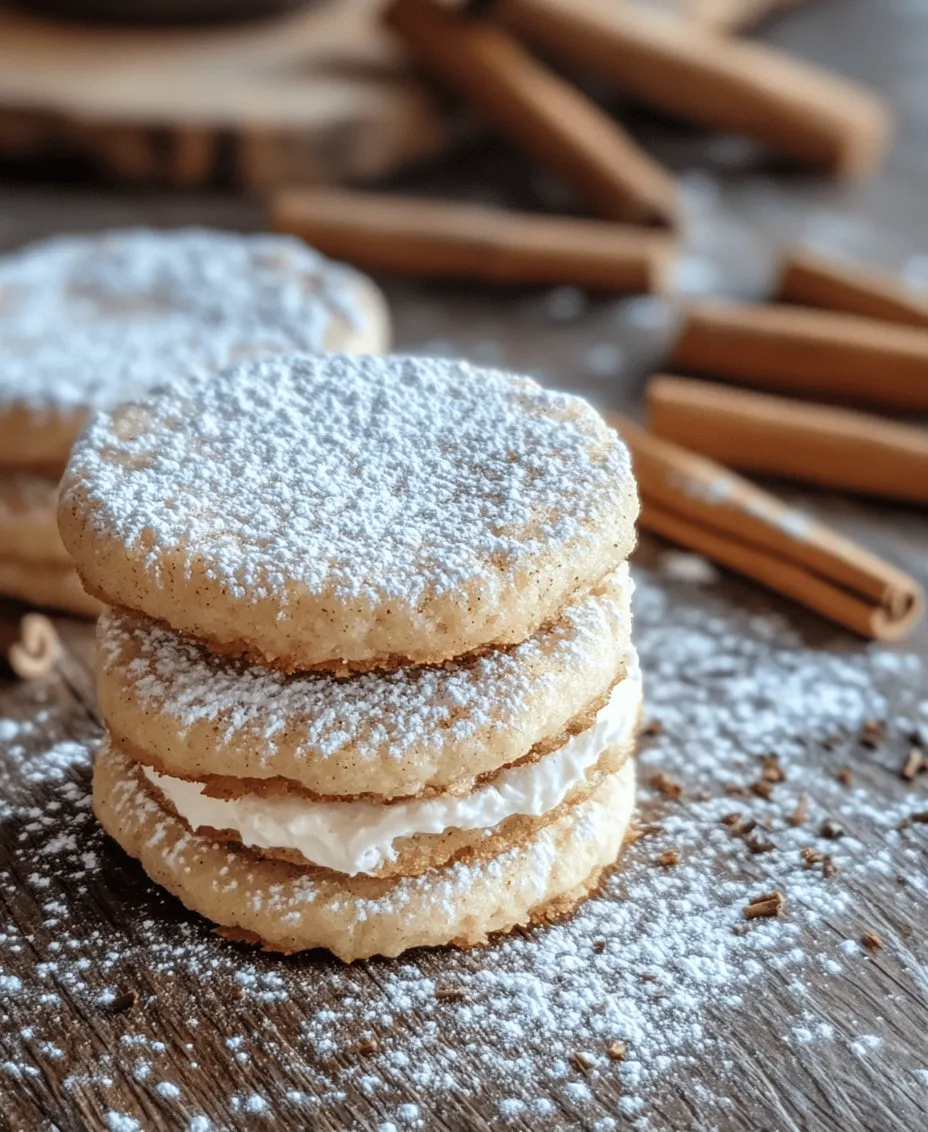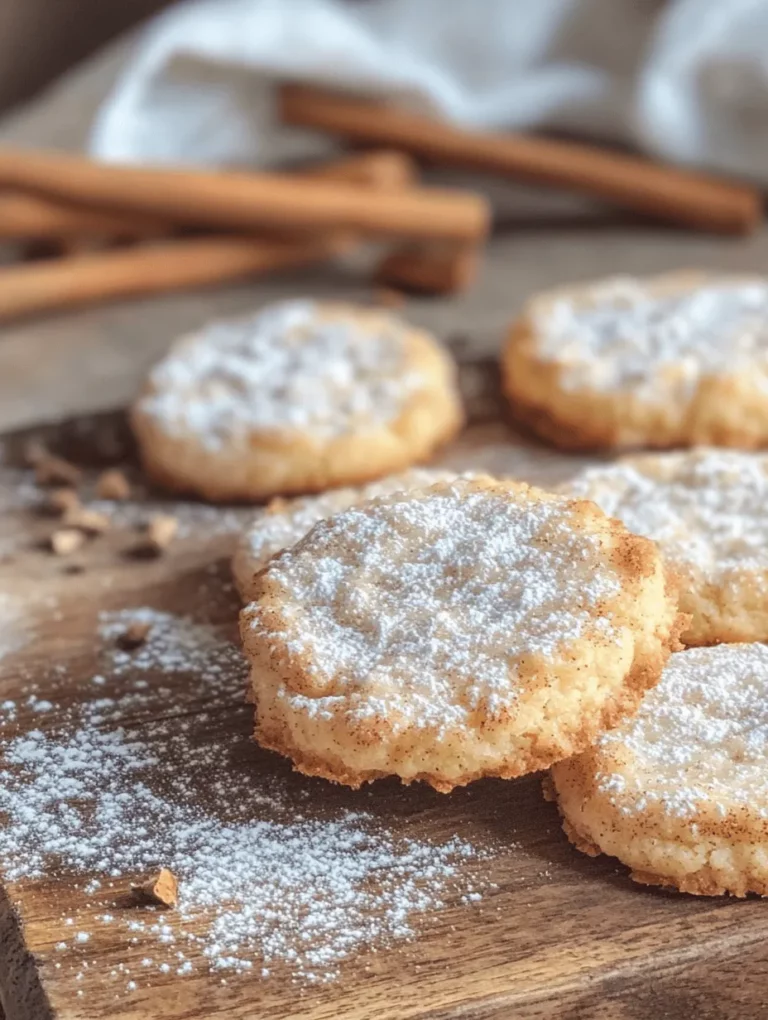Introduction
Welcome to the delightful world of baking, where creativity meets comfort and every recipe tells a story. Today, we are excited to share with you our scrumptious Cinnamon Cream Cheese Cookies, a treat that perfectly blends the rich, tangy flavors of cream cheese with the warm, inviting spice of cinnamon. These cookies are wonderfully soft and slightly chewy, making them the ideal indulgence for any occasion.
The story behind these cookies is one of comfort and nostalgia. Inspired by classic cookie recipes, we have added a twist that elevates the traditional flavor profile. The incorporation of cream cheese not only enhances the taste but also alters the texture, resulting in cookies that are tender and melt-in-your-mouth delicious. Whether you’re preparing them for a family gathering, a festive celebration, or just a cozy night in, these cookies are sure to impress your friends and family alike.
In this comprehensive guide, we will walk you through every step of the process, from gathering your ingredients to enjoying the delicious finished product. No matter your skill level in the kitchen, you’ll find valuable insights and tips that will make your cookie-baking experience a success. So, let’s dive into the world of Cinnamon Cream Cheese Cookies and discover why they are a must-try recipe!
Understanding the Key Ingredients
Baking is as much a science as it is an art, and understanding the role of each ingredient is crucial for achieving the perfect cookie. Let’s break down the key ingredients that make these Cinnamon Cream Cheese Cookies unique and delicious.
Exploring the Role of Cream Cheese
Cream cheese is the star of this recipe, providing a unique flavor profile and a rich, creamy texture that sets these cookies apart from traditional varieties. The tanginess of the cream cheese balances beautifully with the sweetness of the sugar, creating a delightful taste sensation.
Moreover, cream cheese plays a significant role in the moisture content of the cookies. Its fat content helps to keep the cookies soft and tender, preventing them from becoming dry or crumbly. The result is a cookie that remains fresh and delicious for days, making them perfect for baking in advance and sharing with loved ones.
The Importance of Unsalted Butter
In baking, the choice of butter can greatly influence the end result. Unsalted butter is preferred in this recipe for a few reasons. First, it allows for better control over the salt content in the cookies. By using unsalted butter, you can add just the right amount of salt to enhance the flavor without overpowering it.
Additionally, butter contributes to the overall texture of the cookies. When creamed together with sugar and cream cheese, unsalted butter helps to create a light and airy mixture that leads to a tender cookie. The melting of the butter during baking also creates a delightful spread, resulting in cookies that are both soft in the center and slightly crisp on the edges.
The Sweetness of Granulated Sugar
Granulated sugar is a staple in cookie recipes, and for good reason. It not only sweetens the cookies but also affects their texture. When sugar is creamed with butter and cream cheese, it creates air pockets in the mixture, which contributes to the lightness of the cookies.
The science behind sugar in cookie recipes extends beyond just the sweetness. Sugar also helps to retain moisture in the cookies, ensuring they stay soft and chewy. As the cookies bake, the sugar caramelizes slightly, adding a subtle depth of flavor that enhances the overall taste experience.
The Function of Flour and Leavening Agents
All-purpose flour is the backbone of any cookie recipe, providing the structure needed to hold the cookies together. The flour absorbs moisture and, when combined with the wet ingredients, forms gluten, which gives the cookies their chewy texture. It’s important to measure your flour correctly to avoid dense cookies—too much flour can lead to a dry end product.
In addition to flour, leavening agents like baking powder and baking soda play a crucial role in the texture and rise of the cookies. Baking powder provides lift, ensuring the cookies bake up fluffy and light. On the other hand, baking soda helps to create a spread and browning effect during baking, contributing to that perfect golden color we all love.
Spices and Flavor Enhancers
No cookie would be complete without the warm, comforting notes of spices. Ground cinnamon is the star spice in this recipe, infusing the cookies with its signature flavor. Cinnamon not only adds warmth but also enhances the sweetness of the cookies, creating a harmonious balance of flavors.
To elevate the taste even further, we incorporate a splash of vanilla extract. This classic flavor enhancer adds depth and complexity, rounding out the overall flavor profile of the cookies. The combination of cinnamon and vanilla creates a delightful aroma that will fill your kitchen and entice everyone around.
Baking Process Breakdown
Once you’ve gathered your ingredients and understood their roles, it’s time to dive into the baking process. The key to successful cookie baking lies in preparation and technique, so let’s break down the essential steps to ensure your Cinnamon Cream Cheese Cookies turn out perfectly every time.
Preparing Your Workspace
Before you begin baking, it’s essential to prepare your workspace. A clean and organized kitchen makes the baking process smoother and more enjoyable. Gather all your ingredients and tools beforehand to avoid any last-minute scrambles. You’ll need the following essential tools:
– Mixing bowls: A large mixing bowl for creaming the ingredients and a smaller bowl for dry ingredients.
– Hand mixer or stand mixer: For efficient creaming and mixing.
– Measuring cups and spoons: Accurate measurements are crucial for baking.
– Baking sheets: Ensure they are lined with parchment paper or silicone baking mats to prevent sticking.
– Cooling rack: To cool the cookies after baking.
Having everything in place will help you focus on the joy of baking rather than searching for tools or ingredients mid-recipe.
Preheating the Oven
An important step in the baking process is preheating the oven. Preheating ensures that the cookies bake evenly and achieve the desired texture. For these Cinnamon Cream Cheese Cookies, you’ll want to preheat your oven to 350°F (175°C).
The significance of preheating cannot be overstated—if you place cold cookie dough into a cold oven, the cookies may spread too much before they have a chance to set, leading to flat and undesirable results. Take this time to prepare your baking sheets and line them in readiness for the cookie dough.
Creaming Technique
Now, let’s move on to one of the most crucial steps in baking cookies: the creaming technique. This step is essential for achieving the perfect cookie texture. Start by placing your unsalted butter and cream cheese in a large mixing bowl. Using a hand mixer or stand mixer, beat the butter and cream cheese together on medium speed until the mixture is smooth and creamy.
The goal here is to incorporate air into the mixture, which will help create a light and tender cookie. Continue to beat the mixture until it becomes pale and fluffy, which usually takes about 2-3 minutes. This is the moment when your kitchen will fill with the delightful aroma of creamy goodness, setting the stage for the delicious cookies to come.
Incorporating Eggs and Flavorings
Once you’ve achieved the perfect creamy mixture, it’s time to add the eggs and flavorings. Beat in the eggs one at a time, ensuring each egg is fully incorporated before adding the next. This step is vital, as it helps to emulsify the ingredients and adds moisture to the dough.
After the eggs are mixed in, add in your ground cinnamon and vanilla extract. These flavor enhancers will elevate the cookies, providing that comforting and aromatic quality we all love. Mix everything until just combined, taking care not to overmix, as this can lead to denser cookies.
By following these initial steps, you’ll be well on your way to creating a batch of Cinnamon Cream Cheese Cookies that are sure to bring smiles to the faces of those who taste them. In the next part of our guide, we will continue with the remaining instructions, including how to combine the dry ingredients and the baking process. Stay tuned for delicious details!

The Role of Eggs in Binding Ingredients
Eggs are a crucial component in many baking recipes, including our Cinnamon Cream Cheese Cookies. They serve primarily to bind the ingredients together, ensuring that the cookies maintain their shape while baking. The proteins in the egg coagulate when heated, which helps create structure and stability in the final product. Additionally, eggs contribute moisture and richness, enhancing the overall texture and flavor of your cookies. When preparing your dough, be sure to use room temperature eggs; this helps them mix more easily with other ingredients, ensuring a smoother, more uniform batter.
Tips for Ensuring Even Distribution of Flavors
To achieve the best flavor in your cookies, it’s essential to distribute all the ingredients evenly. Start by mixing the cream cheese well with the sugar until fully combined, ensuring that the cream cheese is at room temperature for easier blending. Gradually add in the spices, such as cinnamon and nutmeg, as well as the dry ingredients to ensure a consistent taste throughout the dough. Avoid adding all the dry ingredients at once; instead, add them gradually while mixing. This technique helps prevent clumping and guarantees that every cookie is bursting with flavor.
Mixing Dry Ingredients
Importance of Whisking and Sifting
Before incorporating the dry ingredients into your dough, it’s vital to whisk and sift them. This step aerates the flour and helps prevent any lumps from forming, which can lead to uneven texture in your cookies. Sifting also allows for a more accurate measurement of flour, ensuring you don’t accidentally add too much. For our Cinnamon Cream Cheese Cookies, you’ll want to sift together the all-purpose flour, baking powder, baking soda, and salt. This process will create a light, fluffy base for your cookies, setting the stage for a perfect bake.
How to Properly Combine Dry Ingredients for an Even Dough
Once you’ve whisked and sifted your dry ingredients, it’s time to combine them for an even dough. Make a well in the center of your flour mixture and gradually add the wet ingredients. Use a spatula or wooden spoon to gently fold the flour into the wet ingredients. Be careful not to overmix, as this can lead to tough cookies. The goal is to mix until just combined, with no visible flour remaining.
Combining Wet and Dry Ingredients
Techniques for Effective Mixing Without Overworking the Dough
When combining your wet and dry ingredients, use a gentle folding technique. This method involves lifting the mixture from the bottom and folding it over the top. Repeat this motion until the ingredients are just combined. Overworking the dough can activate the gluten in the flour, resulting in cookies that are tough rather than tender. You’ll know that your dough is ready when it pulls away from the sides of the bowl and holds its shape without being overly sticky.
Signs That Your Dough is Ready for Scooping
Your dough is ready for scooping when it is cohesive and slightly tacky to the touch but not overly sticky. It should hold together when pressed and be easy to scoop with a cookie scoop or tablespoon. If your dough feels too soft, you can chill it in the refrigerator for 15-30 minutes to firm it up, making it easier to handle.
Scooping and Shaping Cookies
Best Practices for Portioning Cookie Dough
When it comes to portioning your cookie dough, consistency is essential for even baking. Use a cookie scoop to ensure that each cookie is the same size. This method not only ensures uniformity in baking time but also results in a more aesthetically pleasing presentation. Aim for about two tablespoons of dough per cookie, placing them on your baking sheet with enough space to allow for spreading.
Importance of Spacing on the Baking Sheet
Spacing your cookies properly on the baking sheet is crucial to avoid them merging into one another as they bake. Leave at least two inches between each cookie to allow for expansion. This will help maintain their distinct shape and texture, resulting in beautifully baked cookies.
Baking the Cookies
Monitoring the Bake Time
Baking time can vary depending on your oven and the size of your cookies, but generally, Cinnamon Cream Cheese Cookies will need around 10-12 minutes at 350°F (175°C). Keep a close eye on them as they bake; you’ll know they are done when the edges are lightly golden and the centers appear set but still soft. The cookies will continue to firm up slightly as they cool, so it’s better to take them out a little early than to overbake.
Understanding the Science of Cookie Baking and Carryover Cooking
Understanding carryover cooking is key to perfecting your baking. This phenomenon occurs when cookies continue to cook even after being removed from the oven due to residual heat. Therefore, removing your cookies from the oven while they still appear slightly underbaked ensures that they will not become dry or hard as they cool. Aim for a golden-brown edge while the center remains soft and slightly puffy.
Cooling the Cookies
The Importance of Cooling on a Wire Rack
After baking, transfer your cookies to a wire rack to cool. This step is essential as it allows air to circulate around the cookies, preventing them from becoming soggy on the bottom. If you leave them on the baking sheet, they may continue to cook and become overly firm. For optimal texture, let your cookies cool on the rack for about 10-15 minutes before moving them to a serving plate.
Ideal Cooling Times for Perfect Texture
For the best texture, allow your cookies to cool completely before serving. This rest time helps the flavors meld together and allows the cookies to firm up, making them easier to handle. If you’re feeling impatient, waiting at least 30 minutes will yield cookies that are still warm but not overly soft.
Dusting with Powdered Sugar
Techniques for Dusting Cookies Evenly
Once your cookies have cooled, you can elevate their presentation by dusting them with powdered sugar. Use a fine-mesh sieve to sprinkle the sugar evenly over the tops of the cookies. This technique ensures an even layer of sugar, creating a visually appealing contrast against the golden-brown cookies. Be sure to dust them just before serving to maintain the sugar’s fresh look.
Aesthetic and Flavor Benefits of Powdered Sugar
Dusting your Cinnamon Cream Cheese Cookies with powdered sugar not only enhances their appearance but also adds a touch of sweetness that complements the warm spices in the cookies. The visual appeal of the white sugar against the cookie’s surface creates an inviting look that is perfect for gatherings or special occasions.
Serving Suggestions and Pairings
Perfecting the Presentation
To serve your Cinnamon Cream Cheese Cookies, consider arranging them on a decorative platter or cake stand. For an added touch, you can garnish the plate with cinnamon sticks or a sprinkle of additional powdered sugar. Displaying them alongside seasonal fruits, such as apples or pears, can create an inviting and rustic presentation that will impress your guests.
Creative Ways to Showcase Your Cookies at Gatherings
When hosting a gathering, consider creating a dessert table featuring your cookies alongside other treats. Use tiered stands to display an assortment of cookies, allowing guests to mix and match their favorites. You could also create gift boxes filled with cookies to share with friends and family, making them an enjoyable takeaway treat.
Pairing Ideas
Beverages That Complement the Flavor of the Cookies
Cinnamon Cream Cheese Cookies pair wonderfully with a variety of beverages. For a warm option, serve them with a cup of spiced chai or hot apple cider. Alternatively, a glass of cold milk or a creamy latte enhances the cookie’s flavors, making for a comforting treat. For those who prefer tea, consider herbal blends with cinnamon or vanilla notes to complement the cookies’ flavor profile.
Other Desserts That Harmonize with Cinnamon Cream Cheese Cookies
These cookies can also be served alongside other desserts to create a delightful dessert spread. Consider pairing them with a rich chocolate cake or creamy cheesecake. The combination of flavors will cater to different palates, ensuring that everyone finds a sweet treat to enjoy.
Conclusion
In conclusion, Cinnamon Cream Cheese Cookies are an irresistible addition to any dessert table. With their soft texture and delightful flavor combination, they offer a unique twist on traditional cookies. By following the steps outlined in this guide, you can confidently bake a batch that is sure to be a hit. Whether enjoyed alone or shared with loved ones, these cookies embody the warmth and joy of baking. Embrace the art of cookie-making, and savor the delicious results of your hard work!

